Key takeaways:
- Effective homelessness charity efforts require understanding individual stories and fostering community connections.
- Local activism enables rapid, tailored responses to community needs and builds trust among members.
- Collaborations with organizations and local businesses enhance resources and create innovative solutions.
- Measuring impact involves both quantitative metrics and qualitative feedback to fully understand initiatives’ effectiveness.
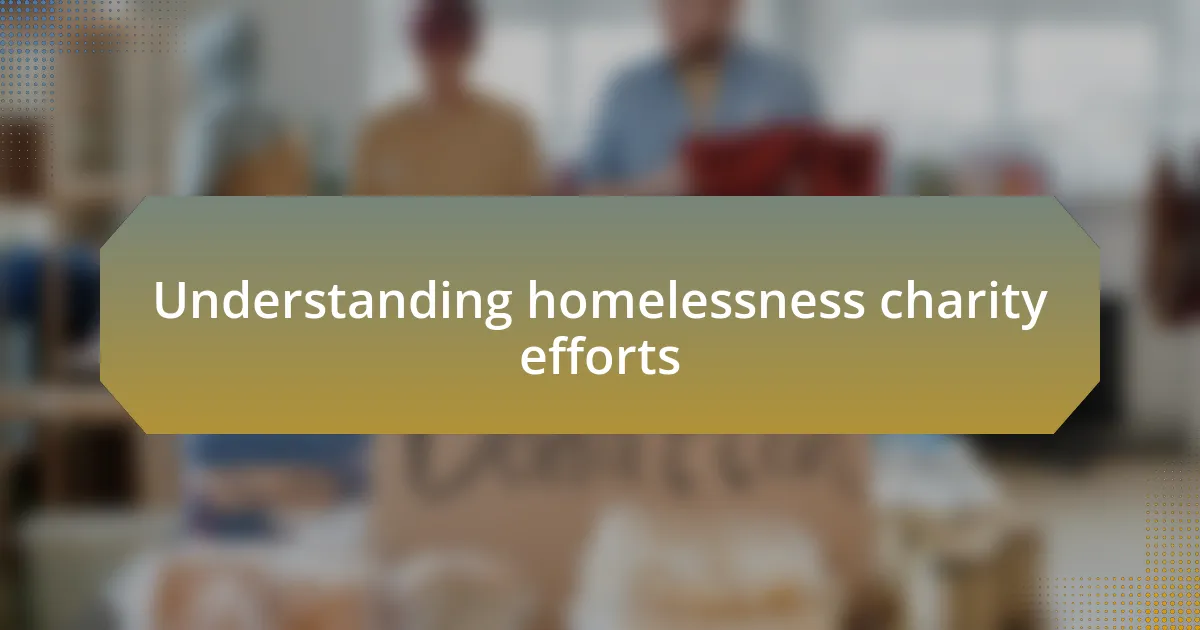
Understanding homelessness charity efforts
Understanding homelessness charity efforts involves recognizing the complexity of the issue and the range of responses from various organizations. I’ve seen firsthand how different charities tackle this challenge. For instance, a local charity I volunteered with didn’t just provide food; they also offered job training programs, which created a ripple effect for individuals seeking sustainable change in their lives.
One thing that often strikes me is the power of community connections. I recall a cold winter night when we set up a warming shelter. The stories shared around that space opened my eyes to the diversity of experiences in homelessness. Each person I met had a unique journey that shaped their situation. This made me wonder: how often do we look beyond the statistics and truly understand the human stories behind homelessness?
Moreover, effective charity efforts are built on collaboration. I remember a project where multiple organizations came together to address homelessness during a city-wide initiative. It showed me how pooling resources and knowledge can lead to innovative solutions that single charities, working in isolation, might overlook. Isn’t it fascinating how collaboration can amplify impact and bring about lasting change?
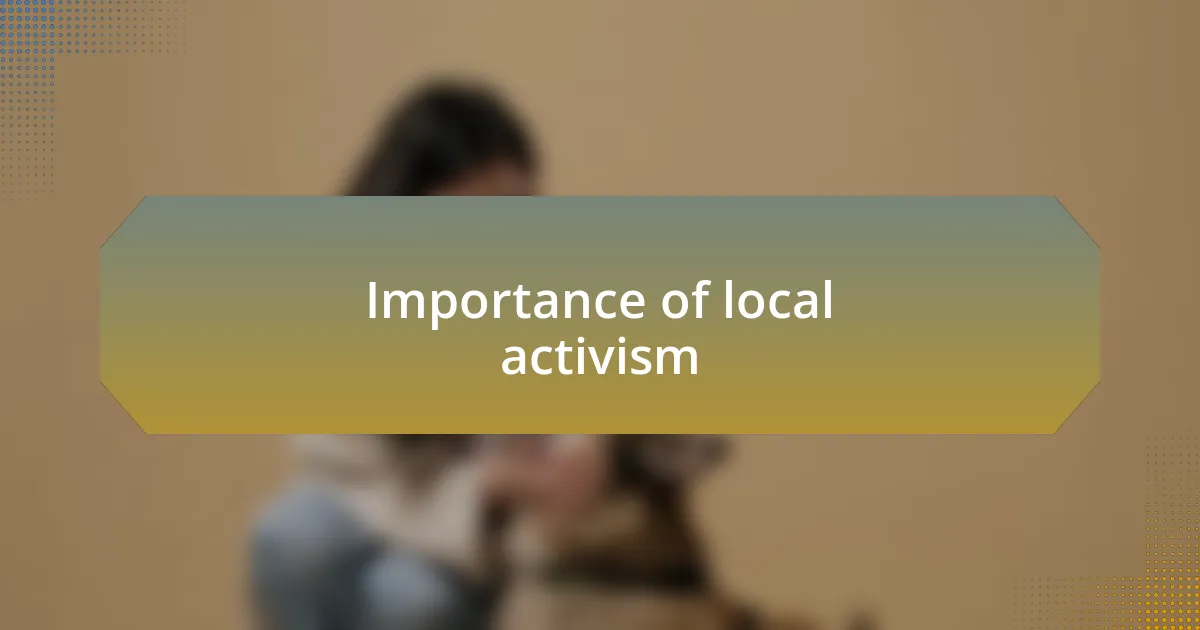
Importance of local activism
Local activism plays a crucial role in addressing the unique needs of our communities. I vividly remember joining a neighborhood meeting aimed at tackling homelessness in my area. Hearing residents share their concerns and ideas energized me; it underscored how personal investment can create solutions tailored to local issues. Have you ever considered how much impact community members can have when they unite for a common cause?
Moreover, the immediacy of local activism allows for rapid responses to needs that larger organizations may overlook. I once joined a grassroots effort to distribute care packages after a sudden influx of families living in their cars. The urgency we felt fueled our actions, creating a sense of resilience and hope within the community, reminding me that local initiatives often respond with heart and speed that larger entities might not. Isn’t it inspiring to see how individuals can come together and make a tangible difference?
Lastly, local activism fosters deep connections and builds trust among community members, which is irreplaceable. I recall volunteering at a local outreach event where we listened to stories from those experiencing homelessness. It was a reminder that the voices of the community are powerful; they pave the way for sustainable change. This experience reinforced my belief that when we engage directly with those we aim to help, we cultivate understanding and empathy. How can we ever truly address homelessness without first forming these vital connections?
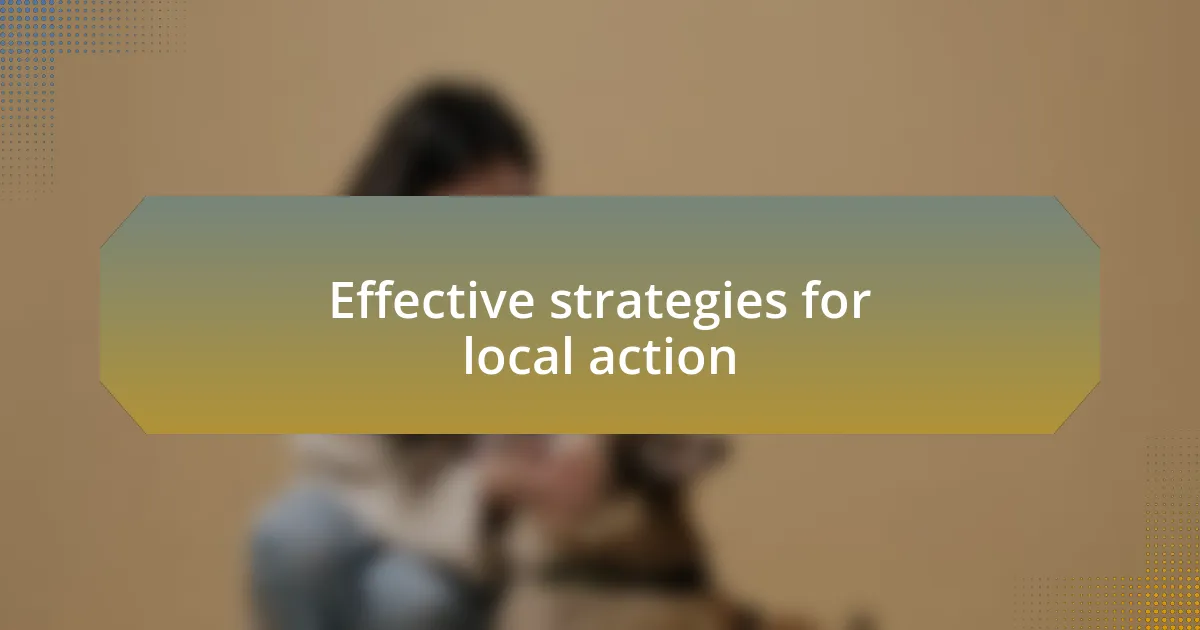
Effective strategies for local action
Local action thrives when it focuses on specific tasks rather than trying to tackle everything at once. I remember one community project that involved painting a local shelter to create a welcoming environment. By breaking down the larger goal of improving the shelter into manageable actions, we inspired more volunteers to get involved. Have you found that focusing on a singular task can rally more support?
One of the most effective strategies I’ve used involves partnering with local businesses. During a food drive, I approached nearby grocery stores to donate items. Getting local businesses on board not only increased our resources but also forged stronger community ties. It made me realize that businesses often want to give back; they just need to be invited to collaborate. How might your own connections lead to powerful partnerships?
Lastly, storytelling can be an incredibly impactful strategy in local activism. I recall sharing a compelling story at a town hall meeting about a family who found refuge through our local program. The emotions in that story resonated with everyone present, creating a sense of urgency and empathy that statistics alone could not evoke. Isn’t it fascinating how a single narrative can inspire change and motivate a community to act?
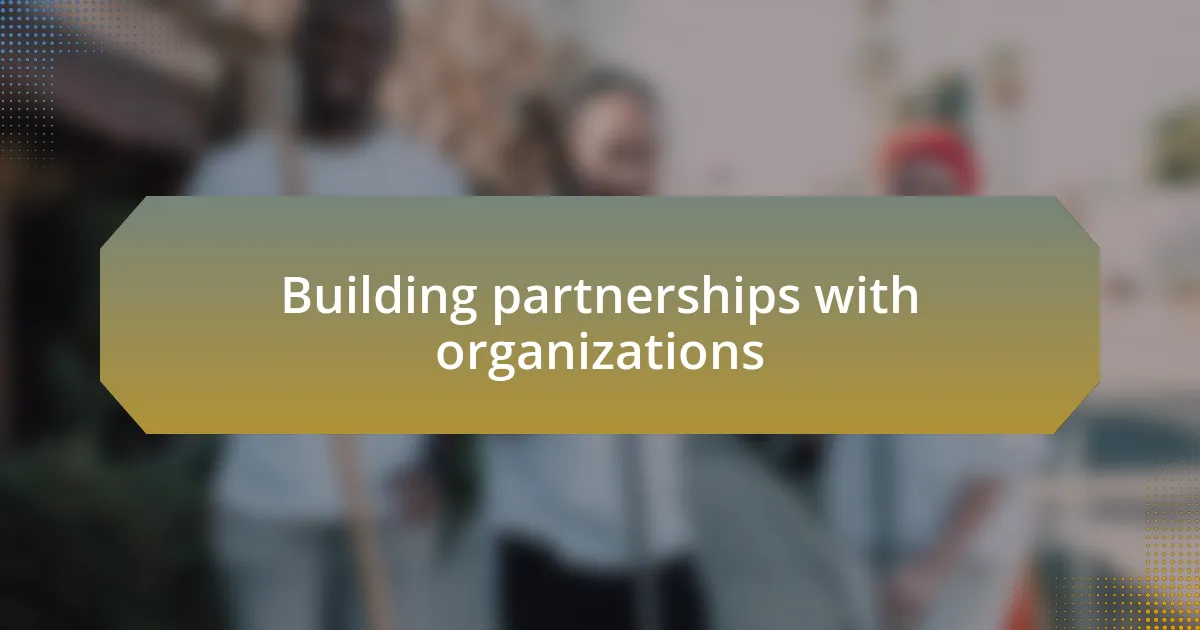
Building partnerships with organizations
Building partnerships with organizations can significantly amplify the impact of local activism. When I first collaborated with a nearby university’s social work program, I was amazed at the wealth of resources they brought to the table. Students not only contributed their time but also their innovative ideas, which breathed new life into our initiatives. Have you ever thought about the untapped potential within your local educational institutions?
In another instance, I reached out to a nonprofit focused on mental health services. Their expertise complemented our housing programs beautifully. Together, we organized workshops that not only provided immediate support for those experiencing homelessness but also addressed underlying issues. It was incredibly rewarding to witness how two organizations could align their missions for a greater good. What unique strengths do you think organizations in your area could bring to your cause?
Moreover, I learned that a regular dialogue with partners is key to sustaining these relationships. During a monthly check-in with our local health department, I discovered their interest in contributing to our outreach efforts. That conversation led to joint events that offered health screenings alongside our food distributions. Isn’t it surprising how a simple chat can open doors to new opportunities for collaboration?
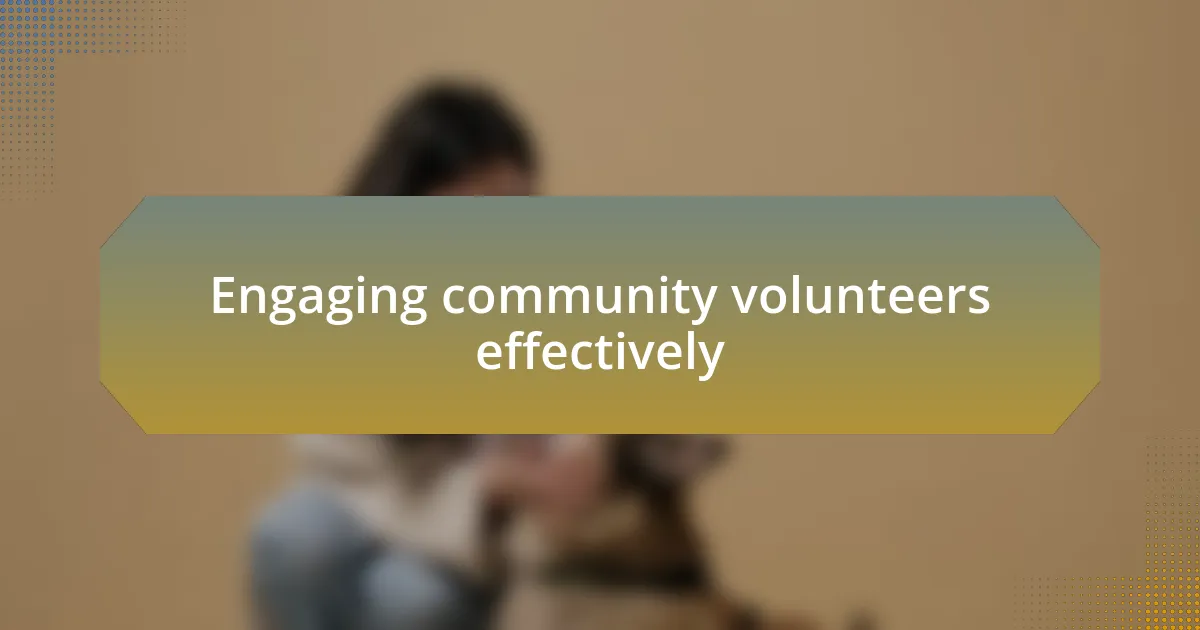
Engaging community volunteers effectively
Engaging community volunteers effectively requires an understanding of their motivations. I remember when I hosted an open meeting to brainstorm ideas for our next volunteer project, and the enthusiasm in the room was palpable. It was fascinating to see how allowing volunteers to share their thoughts led to greater commitment; it’s a reminder that people aren’t just looking for tasks, they want to feel like they’re part of something meaningful. Have you ever considered what drives your volunteers?
One memorable experience for me was when we created small, focused teams based on individual interests and skills. By aligning those interests with specific tasks—like organizing events or distributing supplies—I witnessed a remarkable transformation in engagement. Volunteers were not only more productive but also happier. They took ownership of their roles, which, in turn, created a ripple effect of enthusiasm throughout our group. How often do we underestimate the power of personal connection in volunteer work?
Regular recognition of volunteers’ efforts can’t be overlooked either. I fondly recall a small gathering we hosted to thank our volunteers, complete with heartfelt speeches and personalized tokens of appreciation. Seeing their faces light up reminded me that a little gratitude goes a long way in building a committed base. Isn’t it amazing how simple acts of recognition can renew someone’s dedication to the cause?

Sharing personal experiences in activism
Sharing personal experiences in activism can create powerful connections within a community. I vividly recall the first time I shared my own story of encountering homelessness during a college project. As I spoke about my feelings of helplessness and determination, I could see tears in the eyes of some attendees. It was a moment that reinforced the idea that our individual narratives can inspire others and foster empathy—have you ever noticed how raw stories can spark meaningful conversations?
One summer, I organized a workshop where individuals shared their own experiences with activism and community service. The stories ranged from uplifting successes to challenging setbacks, and it was eye-opening to witness the range of emotions in the room. As people shared their vulnerabilities, it became evident how these experiences shaped their commitment to our cause. Have you ever thought about how sharing your own challenges might resonate with others and encourage them to open up, too?
I’ve learned that vulnerability can be a catalyst for change. On one occasion, I mustered the courage to share my ongoing struggles with burnout while working on housing initiatives. To my surprise, several participants later approached me, expressing their own similar feelings. This camaraderie reminded me that when we openly share our journeys, it not only validates our feelings but also builds a stronger, more supportive activist community. Have you considered how your own experiences might empower others in their activism?

Measuring impact of local initiatives
Measuring the impact of local initiatives can often feel like navigating through a fog; the results may not always be immediately visible. I recall a project focused on providing meals to those in need, where we initially struggled to gauge our success. However, simple conversations with recipients revealed that our efforts provided not just nourishment but also a sense of belonging. Isn’t it fascinating how something as basic as a meal can resonate on such a personal level?
I learned that developing clear metrics—like tracking the number of meals served or the frequency of engagement—can help illustrate the changes we’re making. Yet, as I dug deeper, I realized that qualitative feedback, such as personal accounts of transformation, often tells a richer story. Have you ever thought about how stories can complement statistics, giving a fuller picture of your initiative’s impact?
Ultimately, I believe that continuously revisiting our goals and methodologies is essential. For example, after our meal program, we instituted regular feedback sessions with volunteers and recipients alike. This practice not only strengthened community bonds but also improved our approach, showing me that impact measurement is an ongoing journey, not a one-time assessment. How do you currently gather feedback, and could regular reflection enhance your own initiatives?